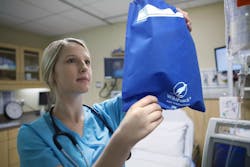The respiratory care profession and field of medicine have been under siege over the past two years with the COVID-19 pandemic driving unprecedented patient volumes at a time when there is a severe shortage of respiratory therapists (RT).
The National Board for Respiratory Care (NBRC), the American Association for Respiratory Care (AARC) and the Commission on Accreditation for Respiratory Care (CoARC) released the results of a recent survey of respiratory care leaders on their joint MoreRts.com website. Nearly 9 in 10 respondents agreed or strongly agreed there is a current, local shortage of RTs, and 84% think a shortage of RTs in the future is likely or very likely.1
In a healthcare environment where there are increasingly more patients with respiratory conditions, not only COVID-19, but also chronic illnesses such as asthma and chronic obstructive pulmonary disease (COPD), the number of RTs is rapidly shrinking. The survey also found:
- 93% of RTs say burnout is a major issue with 72% saying they are feeling the effects
- 92,000+ RTs will retire by 2030, while healthcare needs to retain more than 155,000 RTs to meet current patient needs
- 27% decrease in RT education program enrollment, with only 10% of programs at capacity, while there is a 19% projected increase for RT jobs by 20291
While respiratory industry associations, healthcare organizations, and RT schools are working to retain current RTs and recruit new people into the field, there is also a role and responsibility for respiratory care suppliers to help support and sustain the profession.
“As we look ahead, our basic need is to have more persons aspire to become respiratory therapists. This growth can only happen if career seekers are first aware of the existence of our profession,” Tooley added.
Why are suppliers important to the RT profession?
On the surface, the role of suppliers in respiratory care is clear; they provide the supplies, equipment and services needed for patient care delivery. The AARC and Boston Scientific conducted an online survey of 87 hospital-based respiratory therapists, managers and directors in the U.S. from July 9 to August 9, 2021. When asked what their barriers to patient care were, the top answer was talent/being understaffed at 67%, which is no surprise. The other top responses were associated with technology and workflows, with 65% of respondents naming technology availability/functionality/performance as a barrier, 45% operational inefficiencies, and 37% lack of training.
When asked for three procedures where they want to see advancements, RTs named:
- Mechanical ventilation to decrease barotrauma and improve modes (50%)
- Secretion management to provide smaller, more effective removal solutions (41%)
- Aerosol therapy to deliver higher quality nebulizers with shorter deposition (35%)2
How can suppliers help?
Clearly technological innovation is important to alleviating the burden on RTs and helping them deliver patient care more effectively and efficiently, but supplier support of education, training, and leadership development may be just as important.
Innovate with technology
One way that respiratory care equipment and supply manufacturers can help the RT profession is through technology that streamlines workflows, according to Coombs. He points to closed loop ventilation strategies, such as Smartcare/PS, for automated/protocol-based weaning, and airway pressure release ventilation (APRV) with Autorelease, as technologies that make it easier and more efficient for RTs to care for patients in respiratory distress. He also recommends a comprehensive ventilation workstation approach that accommodates invasive, non-invasive, and 02 therapy.
Alan Haynie, RRT, Clinical Educator, Verathon, says RTs are seeking ways to increase staff efficiency to compensate for staff shortages and that single-use devices can help, stating:
“Single-use devices do not require reprocessing, which reduces workload and has the added bonus of patient safety benefits. One possible solution is to consider utilizing single-use devices to streamline workflow to save time as reprocessing an endoscope takes up valuable staff time.”
Verathon offers single-use GlideScope Spectrum video laryngoscopes and single-use BFlex bronchoscopes as part of its Total Airway Solution. Its GlideScope Core airway visualization workstation is compatible with both devices, enabling clinicians to perform video laryngoscopy, bronchoscopy, and dual-view airway procedures through a single system.
“BFlex and Spectrum can be used simultaneously to help with difficult airways and provide timely and effective patient care in the OR, ICU and ED,” said Haynie. “Verathon has a staff of clinical educators that will help with product education and implementation. We also offer an education program to familiarize your staff with product offerings and to optimize workflow.”
It is not only the respiratory device itself that can spread infection but also how it is stored. For hospitalized patients requiring ongoing delivery of medication via a nebulizer for treatments such as pneumonia, the RT often administers the therapy using a reusable nebulizer that must be stored between use. In most cases, the storage receptacle is a clear, polyethylene plastic bag.
Research has shown that dangerous microbes (e.g., MRSA, VRE) can survive on polyethylene plastic for up to 90 days.4 Considering the RT must handle the plastic bag and the nebulizer multiple times per day to administer therapy, it is easy to imagine how microbes could spread to these items – and subsequently to the RT and other patients.
Recognizing this risk, Meredith Lloyd, LVN, invented the WikiPouch (formerly IP-Pouch) while working as an Infection Control Nurse at a healthcare facility in California. Made from a breathable wicking material that removes moisture and allows microbes to die naturally, WikiPouch serves as a replacement technology for the plastic bags used for storing reusable nebulizers and other respiratory devices, such as nasal cannulas.
A study at California State University found a 62% reduction in Staphylococcus-contaminated cannulas immediately after transfer from polyethylene plastic bags to WikiPouch polypropylene mesh bags.5 Hatfield says the product’s manufacturer, Infection Prevention Products, offers hospitals samples of the WikiPouch for testing at no charge.
Generate awareness
Raising public awareness for the respiratory profession is one way to help address the current crisis, and is a key pillar of the AARC, CoARC and NBRC’s multi-year, national campaign to bring more respiratory therapists into the profession and advance specialization.
“Medtronic partnered with the AARC in their effort to recruit new talent through our sponsorship of their Thank an RT campaign, designed to raise awareness of the profession. We also offer best-in-class education with our on-demand, product-agnostic ventilator training - Ventilator Academy (www.ventilators.com) — to help the onboarding process for new RTs. We understand RTs have large demands on their time. The suite of software features on the Puritan Bennett 980 ventilator can help clinicians manage patients, from adults to neonates.”
Support RT education
In response to the RT shortage crisis, multiple stakeholders are investing in RT education to boost enrollment in programs and provide RT students the resources they need to enter the profession quickly, effectively, and safely upon graduation.
For example, the Pittsburgh-based Community College of Allegheny County’s Respiratory Therapy Associate of Science Degree program recently announced that it has partnered with the University of Pittsburgh Medical Center (UPMC) on a joint initiative to help fill the RT shortage. Program participants receive $6,000 in tuition assistance and paid work opportunities while enrolled in the 18-month program, as well as a guaranteed job at UPMC upon successful program completion.6
From the manufacturer side, Dräger has made annual device donations to U.S. RT schools to help advance RT education with over 110 devices donated to date. Coombs comments on the program:
“Equipping RT schools with advanced technologies is important to preparing students for real-world application of their skills. Students should be training on the same caliber of ventilators and other respiratory care devices and supplies they will be using in healthcare facilities upon graduation.”
With regards to continuing education, Dräger offers complimentary continuing respiratory care education (CRCE) courses and live webinars through its website A Breath Ahead. Additionally, Dräger’s agreement with the Intensive Care Online Network (ICON) provides all Dräger ventilation customers access to online continuing education and a real-time support system 24x7 staffed by clinicians through ICON’s Critical Care Resource Center.
The future of respiratory care
With an ever-increasing population of patients with respiratory conditions, and the trend towards treating patients in lower acuity and lowering cost settings outside of the hospital, the future of the respiratory care field and that of the RT professional will continue to evolve in the years ahead.
COVID-19 patients with lingering respiratory challenges are often transitioned from the intensive care unit (ICU) to non-acute facilities (e.g., long-term care center, skilled nursing facility). But as McKesson states its recent Roadmap to Respiratory Season Success in Non-Acute Settings eBook:
“In most cases, non-acute care clinicians have never had to manage patients with this level of clinical complexity. For example, while they care for patients requiring supplemental oxygen, the respiratory needs of some COVID-19 patients often exceed a facility’s resources.”
“Whereas a facility may have only had a handful of patients on two liters of oxygen in the past, they are now administering flows higher than six liters, probably closer to 15, to prevent COVID-19 patients from being re-hospitalized,” said Patricia Reni, registered respiratory therapist (RRT), homecare account manager for McKesson. “This requires an entirely new skill set and thought process among clinicians.”7
One solution that is growing in popularity is remote respiratory monitoring. Researchers from the Worcester Polytechnic Institute Department of Electrical and Computer Engineering published a study on the current state of respiratory monitoring and future methods in today’s “smart and connected health” era. Their research found:
“Continuous and accurate remote monitoring, along with other physiological data, can help caregivers improve the quality of care and allow patients greater freedom outside the hospital. Such monitoring systems could lead to highly tailored treatment plans, shorten patient stays at medical facilities, and reduce the cost of treatment.”8
“Chronic respiratory patients were some of the highest risk patients and often isolated to their homes due to their conditions,” said Golz. “Early in the pandemic, we saw most pulmonology offices close for routine care and doctors spending most of their time in the ICU treating COVID-19 patients. RPM and telehealth together allowed providers to keep a close eye on their patients and enrich their telehealth appointments with physiological data to help make informed treatment decisions remotely.”
According to Golz, many practices have continued using RPM for patients with chronic respiratory conditions because of its clinical value and ease of use, and the peace of mind it offers to providers and patients alike. He said Spire Health has seen a growing number of practices adopting remote monitoring systems and building clinical pathways to incorporate their daily use into patient care.
“As with all new fields, there are a lot of players at the beginning,” Golz added. “Throughout the pandemic we have seen insurers and CMS look at adding additional requirements to ensure RPM is providing clinical value to patients. We see this trend continuing with a focus on proving technology solutions such as RPM have a clinical impact on patient outcomes. Further, we see these remote monitoring tools offer ancillary services such as at home pulmonary rehab programs for patients to help live their best quality of life at home.”
References:
1. Why We Need More RTs – and How to Help, https://www.morerts.com/growing-need/
2. The State of Respiratory Therapy: A 2021-2022 Report, AARC and Boston Scientific, https://www.aarc.org/wp-content/uploads/2021/09/the-state-of-respiratory-therapy.pdf
3. Analyst Insight, Ventilator consumables: Repercussions following growth during the pandemic, Signify Research, February 24, 2022
4. Survival of Enterococci and Staphylococci on Hospital Fabrics and Plastic, Journal of Clinical Microbiology, February 2000, https://www.ncbi.nlm.nih.gov/pmc/articles/PMC86187/
5. Survival of bacteria during nasal cannula storage in polyethylene plastic vs mesh bags, California State University, 2013, https://www.ippmfg.com/materials/CSUChicoStudy.pdf
6. CCAC and UPMC establish Respiratory Therapy program partnership to help fill therapist shortage, CCAC, February 23, 2022, https://www.ccac.edu/news/posts/02-23-22-ccac-and-upmc-establish-respiratory-therapy-program-partnership-to-help-fill-therapist-shortage.php
7. Roadmap to Respiratory Season Success in Non-Acute Settings eBook, McKesson, 2021, https://mms.mckesson.com/resources/respiratory-care/the-roadmap-to-respiratory-season-success-in-non-acute-settings
8. Respiratory Monitoring: Current State of the Art and Future Roads, IEEE Reviews in Biomedical Engineering, November 6, 2020, https://ieeexplore.ieee.org/document/9250526
About the Author
Kara Nadeau
Senior Contributing Editor
Kara Nadeau is Sterile Processing Editor for Healthcare Purchasing News.








